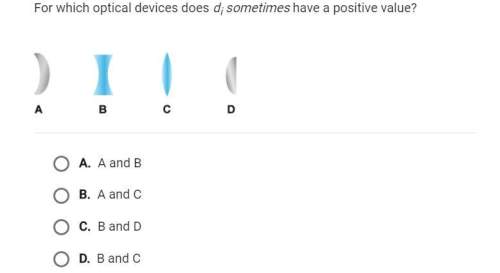
Answers: 3
Another question on Physics

Physics, 21.06.2019 23:00
Follow these directions and answer the questions. 1. set up the ripple tank as in previous investigations. 2. bend the rubber tube to form a "concave mirror" and place in the ripple tank. the water level must be below the top of the hose. 3. generate a few straight pulses with the dowel and observe the reflected waves. do the waves focus (come together) upon reflection? can you locate the place where the waves meet? 4. touch the water surface where the waves converged. what happens to the reflected wave? 5. move your finger twice that distance from the hose (2f = c of c, center of the curvature) and touch the water again. does the image (the reflected wave) appear in the same location (c of c)? you may have to experiment before you find the exact location. sometimes it is hard to visualize with the ripple tank because the waves move so quickly. likewise, it is impossible to "see" light waves because they have such small wavelengths and move at the speed of light. however, both are examples of transverse waves and behave in the same way when a parallel wave fronts hit a curved surface.
Answers: 1

Physics, 22.06.2019 00:30
What are the theoretical properties of a gas at a temperature of 0 kelvin?
Answers: 3

Physics, 22.06.2019 07:50
The ratio of lift to drag l/d for a wing or airfoil is an important aerodynamic parameter, indeed, it is a direct measure of the aerodynamic efficiency of the wing. if a wing is pitched through a range of angle of attack, l/d first increases, then goes through a maximum, and then decreases. consider an infinite wing with an naca 2412 airfoil. estimate the maximum value of l/d. assume that the reynolds number is 9x10^6.
Answers: 2

Physics, 22.06.2019 08:40
An isolated conducting spherical shell carries a positive charge. part a which statement (or statements) about the electric field and the electric potential inside and outside the spherical shell is correct? which statement (or statements) about the electric field and the electric potential inside and outside the spherical shell is correct? electric potential inside the shell is constant and outside the shell is changing as 1/r2 both the electric potential and the electric field does change with r inside and outside the spherical shell electric potential inside and outside the shell is constant, but not zero electric potential inside the shell is constant and outside the shell is equal to zero electric field inside and outside the shell is constant (does not change with the position r), but is not equal to zero electric field inside and outside the shell is changing as 1/r (where r is the distance from the center of the sphere) electric field inside is equal to zero and outside the shell is constant, but not zero electric potential inside the shell is constant and outside the shell is changing as 1/r electric field inside and outside the shell is changing as 1/r2 electric field inside is equal to zero and outside the shell is changing as 1/r2 electric field inside and outside the shell is zero electric field inside is constant and outside the shell is changing as 1/r
Answers: 3
You know the right answer?
Earths rate of rotation is approximately...
Questions

Mathematics, 12.10.2020 01:01

Mathematics, 12.10.2020 01:01

Mathematics, 12.10.2020 01:01

History, 12.10.2020 01:01

Mathematics, 12.10.2020 01:01

Mathematics, 12.10.2020 01:01


Engineering, 12.10.2020 01:01

Spanish, 12.10.2020 01:01

Mathematics, 12.10.2020 01:01

Mathematics, 12.10.2020 01:01

Mathematics, 12.10.2020 01:01

History, 12.10.2020 01:01

English, 12.10.2020 01:01

Mathematics, 12.10.2020 01:01

Mathematics, 12.10.2020 01:01


English, 12.10.2020 01:01

Mathematics, 12.10.2020 01:01

Chemistry, 12.10.2020 01:01




